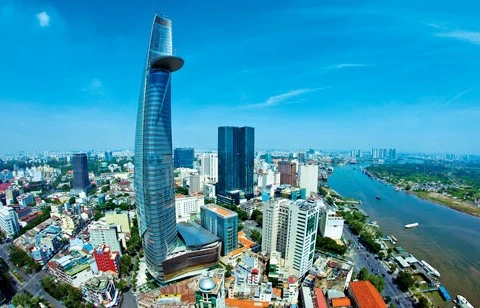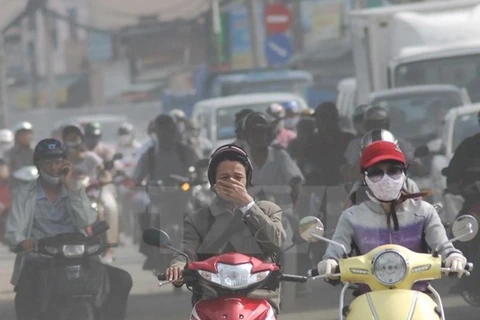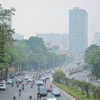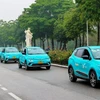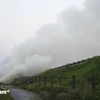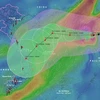 Smokes from factories in the Bien Hoa 1 industrial park, located in Bien Hoa city of the southern province of Dong Nai (Photo: VNA)
Smokes from factories in the Bien Hoa 1 industrial park, located in Bien Hoa city of the southern province of Dong Nai (Photo: VNA) Hanoi (VNA) - Urban citizens, especially children, are being exposed to higher risks of respiratory diseases as air pollution worsens, experts have said.
A national environmental report about to be published by the Ministry of Natural Resources and Environment (MONRE) shows that the amount of nitrogen oxide (NO2), ozone (O3) and carbon monoxide (CO) in the atmosphere have been increasing in urban cities due to traffic, construction and industrial activities, Tien Phong (Vanguard) newspaper reported.
According to medical studies, high concentrations of NO2 can cause injuries to the lung mucosa and increase risks of respiratory diseases, O3 can damage airways and cause inflammation of the cells and CO can reduce oxygen transport in the body which can lead to hypoxemia.
The amount of NO2 and CO tends to increase during peak hours in areas where traffic congestion occurs, and near industrial parks in urban areas, according to the report.
The amount of O3 was found to be higher than permitted levels in all three northern, central and southern regions, especially during hot days, from 12pm to 3pm, Nguyen Van Thuy, director of MONRE’s Centre for Environmental Monitoring (CEM), said at a recent conference.
Dust pollution is also severe. The amount of dust was higher than national permitted levels in some 80 percent of air samples in recent national environment observing programmes, according to reports.
Dust pollution is a major problem in urban air pollution since dust accumulation can cause bone marrow disorders, joint pain, kidney inflammation, high blood pressure, cerebral palsy and respiratory diseases, according to Thuy.
An independent report from the Green Innovation and Development Centre shows that during the first three months of this year, there were 38 days in Hanoi and Ho Chi Minh City when the amount of particulate matters smaller than 2.5µm (as known as PM2.5, which is acidic and harmful to human health) was higher than permitted levels from the World Health Organisation (WHO).
The number of patients receiving treatment at hospitals for respiratory diseases has been on the rise in recent years, and currently accounts for about 3-4 percent of the total population, according to the national environment report.
While the number of children admitted to the HCM City Children’s Hospital 2 for parasitic diseases and infections decreases, the number of those with respiratory diseases has hiked up, averaging 40-50 percent of total inpatients, it said.
In Hanoi, the average cost of medical examination and treatment and medicines for patients with respiratory diseases is 1,500 VND (6.6 cents) per person per day. With some 3.5 million citizens in the inner city, the total economic loss due to respiratory diseases in the capital city is estimated to be some 2 trillion VND (88 million USD) per year, according to the report.
The report also shows that noise levels on major traffic routes often exceed the national permitted level from 6am to 9pm. Noise levels recorded by CEM in 14 monitoring locations in different cities were also higher than permitted.
Not only in areas with high traffic density, noise pollution was also detected near construction sites, and in urban areas where karaoke bars and other types of service businesses use loudspeakers to attract customers.
Doctor Hoang Van The, head of the Occupational Disease Department at the Rehabilitation Hospital – Occupational Disease Treatment Hospital in HCM City, said that noise pollution weakens humans’ natural reflex with sounds, damaging the auditory and nerve systems, and indirectly causing heart-related diseases.
Long-term exposure to excessive noise can damage the inner ear, causing the auditory nerve to shrivel up and harm mental health, he said.
While waiting for a national scheme limiting motorbikes in the inner city in 2030 to take effect, air quality in Hanoi can only be improved with supporting solutions such as planting more trees, creating more detention basins and mechanising environmental sanitation, according to Nguyen Trong Dong, director of the city’s environment department.
The city has compiled a list of 117 factories and production units that cause environmental pollution in the five districts of Hai Ba Trung, Dong Da, Ba Dinh, Thanh Xuan and Ha Dong to be relocated, he said at a recent conference on air quality management in the capital city.
Noise pollution is hard to tackle since service businesses turned down the volume in the presence of patrol officers, and turned it back up when they left, Tien Phong reported.
High-level inspectors only examine and handle major noise violations that affect many people, with smaller violations assigned to lower-level environmental offices in localities, an official from the HCM City environmental protection department was quoted by the newspaper as saying.-VNA
VNA
